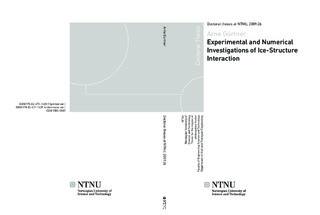| dc.contributor.author | Gürtner, Arne | nb_NO |
| dc.date.accessioned | 2014-12-19T11:26:13Z | |
| dc.date.available | 2014-12-19T11:26:13Z | |
| dc.date.created | 2009-03-10 | nb_NO |
| dc.date.issued | 2009 | nb_NO |
| dc.identifier | 202452 | nb_NO |
| dc.identifier.isbn | 978-82-471-1420-9 (printed ver.) | nb_NO |
| dc.identifier.isbn | 978-82-471-1421-6 (electronic ver.) | nb_NO |
| dc.identifier.uri | http://hdl.handle.net/11250/231382 | |
| dc.description.abstract | Ice interacting with offshore structures is of major engineering concern in areas where human activities and (seasonal) sea ice coexist. This thesis deals with experimental as well as numerical investigations of (level) ice-structure interaction and the typical processes associated with it.
Ice barriers, for the purpose of protecting offshore drilling units and production structures in shallow ice infested waters, have been investigated. This thesis discusses the applicability of two different concepts; (i) Ice Protection Piles (IPPs) and (ii) Shoulder Ice Barrier (SIB). Model tests on IPPs have been analysed as part of this thesis. The effect of varying pile-to-pile distances on the ice interaction was of particular interest. The SIB has been proposed as an innovative design to existing ice protection structures. The concept and heuristic arguments for its design have been presented. The SIB concept was eventually tested in the large ice tank of the Hamburg Ship Model Basin (HSVA). Ice loads, as well as ice rubble build-up mechanisms and ice breaking mechanisms have been studied. The SIB manifested itself as a sound ice barrier concept and may be considered as a good alternative to present ice protection structures in a concept selection phase.
A review of existing numerical techniques for simulating the ice-structure interaction process is summarised in the present work. The merits and drawbacks of previous work have been discussed. This thesis argues for the significance of accounting for dynamic fracture in ice and presents a consistent numerical method to solve it. The method builds upon the cohesive zone approach and implements it into the solution procedure of explicit finite elements. A Computational Cohesive Element Model (CCEM) is proposed for simulating the multi-material problem at hand. It has been shown that ice model tests on IPPs as well as the SIB could be numerically simulated by means of the CCEM with respect to both qualitative and quantitative results. The CCEM has also been employed for studying some aspects of dynamic icestructure interaction. The CCEM facilitates a method to analyse the dynamics of a structure resulting from ice loading as a coupled non-linear dynamical system. | nb_NO |
| dc.language | eng | nb_NO |
| dc.publisher | Norges teknisk-naturvitenskapelige universitet, Fakultet for ingeniørvitenskap og teknologi, Institutt for bygg, anlegg og transport | nb_NO |
| dc.relation.ispartofseries | Doktoravhandlinger ved NTNU, 1503-8181; 2009:26 | nb_NO |
| dc.title | Experimental and Numerical Investigations of Ice-Structure Interaction | nb_NO |
| dc.type | Doctoral thesis | nb_NO |
| dc.contributor.department | Norges teknisk-naturvitenskapelige universitet, Fakultet for ingeniørvitenskap og teknologi, Institutt for bygg, anlegg og transport | nb_NO |
| dc.description.degree | PhD i bygg, anlegg og transport | nb_NO |
| dc.description.degree | PhD in Civil and Transport Engineering | en_GB |
